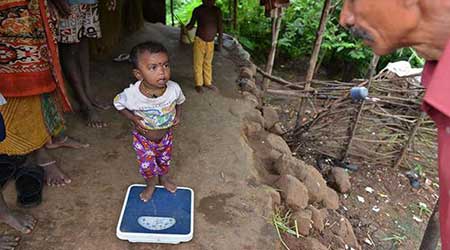Date : 30/05/2023
Relevance: GS-2: Welfare schemes for vulnerable sections of the population by the Centre and States and the performance of these schemes; mechanisms, laws, institutions and Bodies constituted for the protection and betterment of these vulnerable sections.
Key Phrases: UNICEF, WHO, World Bank, Malnutrition, Stunting, Wasting, Sustainable Development Goals, National Family Health Survey, World Health Assembly.
Context
- According to the recently released Joint Malnutrition Estimates by UNICEF, WHO, and the World Bank, India witnessed a reduction of 1.6 crore stunted children under the age of five in 2022 compared to 2012.
Introduction
- India has made significant progress in reducing stunting among children under the age of five, according to the recently released Joint Malnutrition Estimates (JME) report by UNICEF, WHO, and the World Bank.
- However, the report highlights concerns regarding wasting and the growing levels of obesity in the country.
- This article examines the findings of the report, discusses the prevalence of stunting, wasting, and obesity in India, and explores the global trends in malnutrition.
Understanding the Terminology: Wasting, Stunting, and Obesity
- Wasting: Wasting, also known as acute malnutrition, refers to a condition in which a child's weight is significantly lower than what is considered healthy for their height.
- Stunting: Stunting, on the other hand, is a chronic form of malnutrition characterized by impaired growth and development in children. It is measured by comparing a child's height to the average height of children in the same age group.
- Obesity: While wasting and stunting highlight issues of undernutrition, obesity presents a different concern. Obesity is defined as excessive or abnormal accumulation of fat in the body, leading to adverse health effects.
Reduction in Stunting
- India has shown a remarkable reduction in stunting, with 1.6 crore fewer stunted children under five years in 2022 compared to 2012.
- The prevalence rate of stunting decreased from 41.6% in 2012 to 31.7% in 2022. This decline has contributed to a decrease in India's share of the global burden of stunting from 30% to 25% over the past decade.
- The drop in stunting is in line with the findings of the National Family Health Survey (NFHS)-5, which estimated the prevalence of stunting at 35.5% in 2019-2021.
Wasting and Obesity Concerns
- While India has made progress in reducing stunting, wasting continues to be a concern. The prevalence of wasting in India was 18.7% in 2022, accounting for 49% of the global burden of this malnutrition indicator.
- Wasting refers to acute malnutrition over short periods, and its prevalence has remained relatively high in India. It is a complex issue, with two-thirds of wasting in children aged 12 or 24 months being attributed to maternal malnutrition.
- This highlights the need to address maternal malnutrition as a crucial
factor in combating wasting among children.
- Furthermore, the prevalence of obesity in India has marginally increased from 2.2% in 2012 to 2.8% in 2022.
- Although the overall classification for obesity is still low in India
compared to global prevalence, the rise in numbers is concerning.
- Obesity contributes to 8.8% of the global share, indicating the need for preventive measures to curb this growing trend.
Global Trends and Targets
- Globally, there has been a decline in stunting from 26.3% in 2012 to
22.3% in 2022. South Asia has witnessed a sharper decline, with stunting
dropping from 40.3% to 30.5%.
- However, the prevalence of wasting has remained stagnant, with a global prevalence rate of 5.6% in 2022.
- Insufficient progress has been made to achieve the global nutrition targets set by the World Health Assembly (WHA) for 2025 and the Sustainable Development Goal (SDG) 2 targets for 2030.
- Only one-third of all countries are on track to halve the number of stunted children by 2030, and even fewer countries are expected to achieve the target of 3% prevalence for overweight.
Collaborative Efforts and Future Outlook
- The reduction in stunting in India is a result of concerted efforts by various stakeholders, including government bodies, NGOs, and research institutions.
- The collaboration producing the Joint Malnutrition Estimates (JME) report highlights the importance of data-driven interventions to address malnutrition effectively.
- The report provides valuable insights into the prevalence of malnutrition indicators, guiding policymakers and implementers in formulating targeted strategies.
Conclusion:
- India's progress in reducing stunting among children is commendable,
indicating the effectiveness of ongoing initiatives and interventions.
- However, the persisting challenges of wasting and obesity demand sustained efforts and a multi-dimensional approach.
- Addressing maternal malnutrition, improving access to health services,
and promoting healthy eating habits are crucial steps in combating wasting
and obesity.
- The findings of the JME report underscore the global need for accelerated action to achieve the WHA and SDG targets.
- By prioritizing nutrition interventions and collaborating with international agencies, India can continue its journey towards a healthier and nourished population.
Source: The Hindu
Mains Question:
Q. Discuss the findings of the Joint Malnutrition Estimates (JME) report released by UNICEF, WHO, and the World Bank regarding the status of stunting, wasting, and obesity in India. What are the key concerns highlighted in the report? Discuss the implications of these findings for India's efforts to combat malnutrition. (250 words).






















